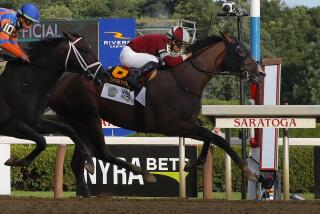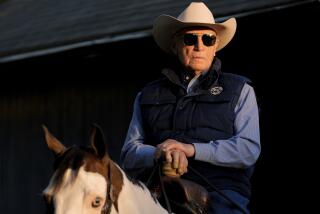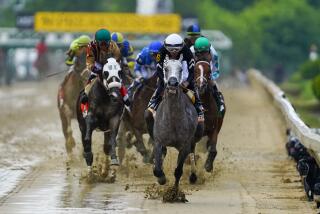Injury Makes Risen Star’s Greatness Tough to Judge
- Share via
It may be premature to start speaking of Risen Star in the past tense, but it seems likely (for both medical and financial reasons) that he has run his last race. If that is the case, how will history evalulate him? How good a racehorse was the son of Secretariat?
Whatever the answer, any appraisal of Risen Star is sure to be tinged with a measure of regret. It is always sad when a racehorse’s career is cut short in his prime, but even sadder when the people managing him won’t give him a chance to show his potential.
Risen Star’s career lasted for 11 races; he won eight and finished in the money in all 11. The majority of these races were run against weak competition in Louisiana; Risen Star’s reputation and his $14 million valuation as a stallion rest solely upon his victories in the Preakness and the Belmont Stakes.
The 1988 Preakness will be remembered more for the way that Forty Niner and Winning Colors lost it than the way Risen Star won it. When the two leaders engaged in a mutually destructive bumping match, Risen Star took advantage, shooting to the lead on the rail while his rivals’ jockeys were paying attention only to each other. Even with everything in his favor, Risen Star didn’t run fast or win by a big margin.
In the Belmont Stakes, of course, he did those things. His time was the second-fastest in the history of the race, and his margin of victory was a dazzling 14 3/4 lengths. But neither of these measurements certified Risen Star’s greatness.
The Belmont racing strip was exceptionally fast on June 11. From the standpoint of speed handicappers, it was not as good a performance as the 4-year-olds Lost Code, Alysheba and Bet Twice have been delivering this season. And Risen Star won so easily because nobody else ran decently. Winning Colors went off form badly. The runner-up, Kingpost, is an unexceptional 3 year old.
Even though Risen Star’s Belmont runaway might not have been as great as it looked, the performance did suggest that the colt had the potential to become a star of the first magnitude.
He was improving steadily, race by race, showing more speed and versatility. He had won the Belmont although suffering from an injury. And he had won both the Preakness and the Belmont without any serious workouts beforehand.
It is possible that trainer Louie Roussel III had somehow found the optimal regimen for his horse, but it is also possible that Risen Star accomplished what he did in spite of Roussel, and that he might reach a new level of performance under different management. Even Roussel acknowledged that, and said he wanted to put Risen Star under the care of Hall-of-Famer Charlie Whittingham next season.
But after the Belmont, Roussel abandoned -- with almost indecent haste -- any such far-reaching plans for his colt. After uttering platitudes all spring about how he wanted to do what was good for the sport, Roussel promptly succumbed to greed and opportunism. Besieged with offers to syndicate Risen Star for future stud duty, he took the money and ran.
Roussel and co-owner Ronnie Lamarque took an offer from Walmac International to syndicate the colt for $14 million and retire him at the end of the 3-year-old year.
When the deal was announced, one of the owners of the Kentucky breeding farm said he could see no point in running the horse as a 4 year old.
No point? How about “the good of the sport”? How about giving Risen Star a chance to show the extent of his talent? This was a revival of an old, deplorable practice that has been one of racing’s curses -- whisking a horse off to stud as soon as he has established himself as a marketable commodity.
Because he won’t run as a 4 year old, Risen Star can’t be given a long period to recuperate from the leg injury that is keeping him on the sidelines now. And if he has not recovered sufficiently to go back in training by the end of this month, he wouldn’t be able to do any meaningful racing as a 3 year old.
So he would be retired long before he reaches his prime. If so, he will be remembered as a good horse who never got an adequate chance to show whether he might have been a great one.
More to Read
Go beyond the scoreboard
Get the latest on L.A.'s teams in the daily Sports Report newsletter.
You may occasionally receive promotional content from the Los Angeles Times.










